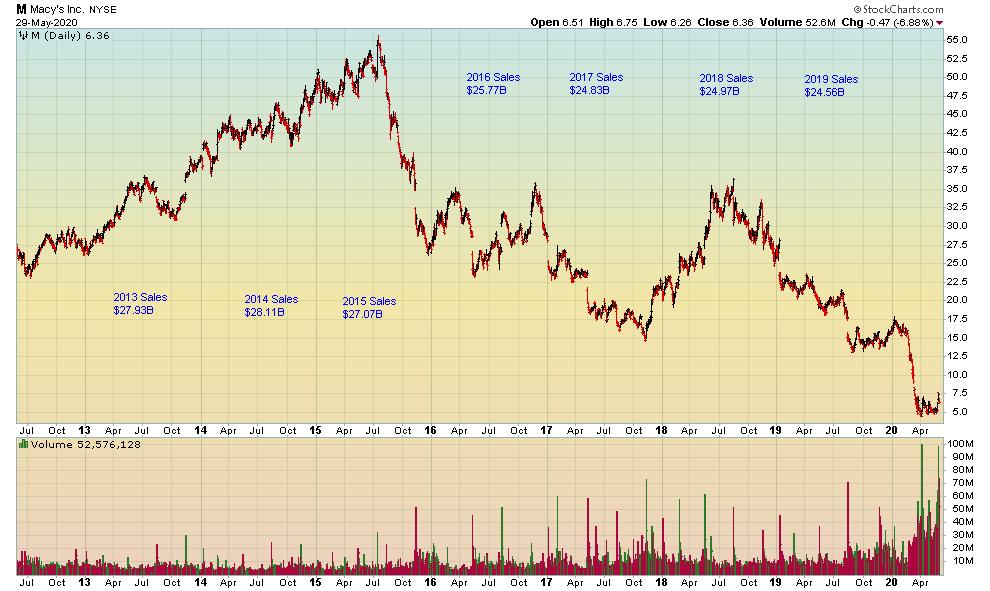 I've acknowledged in numerous previous blogs and in our book that I'm not exclusively a 100% pure chartist. I know... blasphemy!
I've acknowledged in numerous previous blogs and in our book that I'm not exclusively a 100% pure chartist. I know... blasphemy!
Yes, I use fundamentals. I need fundamentals, I won't trade without fundamentals. But the key is that I'm neither a fundamentalist nor a technician. I label myself as a "rational investor". I keep one foot in each camp.
In the fundamentalist camp, I'm an earnings junkie. I follow earnings and earnings dates. I track the trend of analysts earnings projections. Earnings growth rates matter to me as do PEG ratios.
Having said that, earnings is not my one essential fundamental indicator. Instead, it's sales and revenues. Why, you shout — earnings are more important than sales and revenues.
Well, because when I own an equity, protecting my profits is Mission #1.
Too many times over the years, I've seen earnings continue to expand magically since companies can afford the best number crunchers and utilize "Hollywood accounting" tools while sales and revenues are falling. Earnings that are based on smoke, mirrors and cost-cutting strategies with declining revenues can only support an attractive chart for so long. Sometimes longer than you'd guess. The stories at the time always seem so plausible, and the talking heads so persuasive, but inevitably the plunge happens when revenues trend lower.
Protecting my profits dictates that I follow two maxims. To paraphrase Jesse Livermore, "when the market tells you that you are wrong, you must sell and cease being wrong", Jeff Bezos added to the sentiment, saying, "Being wrong might hurt you a bit, but being slow will kill you".
My personal interpretation and the recipe I use is this: "Pull the trigger and don't procrastinate!"
Therein lies the reason that sales and revenue trends are more important to me than the reported earnings. It's a lot harder to manipulate or fabricate sales and revenue data. Witness the Chinese company Luckin Coffee (LK) which just fired both its CEO and COO for sales fraud. It happens, but much less seldom than creative earnings.
I'll present five examples. First, a shout-out to the Value Line service. I'm a subscriber, and they make it very easy to track ten years of sales and revenue. I like easy!
My first example is actually a cluster of retailers. Macy's (M) sales began trending down in 2015 and the chart followed.

Both The Gap (GPS) and Kohl's (KSS) had diminishing sales starting in 2019. Look at those charts, if you dare. General Electric (GE) had sales begin to trend down in 2015 and 2016, but the charts kept hoping and praying for a turnaround. The big decline came in 2016, and it was ugly. Kraft Heinz (KHC) sales turned down beginning in 2016, and the chart levitated for a short time at $84 before soon crashing to $20. For Mylan (MYL), sales began trending down in 2018 while Mosaic (MOS) sales began trending down in 2019. Both are off their highs by two-thirds. You get the point. Back to my mantra: "Pull the trigger and don't procrastinate!"
I'm going to push this even further in hopes of truly convincing my readers that this approach is one you should embrace. Over the longer term, it's difficult for a business to produce attractive returns for investors if it isn't growing its sales and revenues. An example from my own portfolio is Visa (V). Its revenues have grown from $8,065 million in 2010 to $22.8 billion over 10 years. Correspondingly, its stock price has appreciated from $15 to $190. Contrast this with Macy's (M). Its sales in 2010 were $25 billion and have drifted lower over 10 years down to $21.71 billion. Its stock price likewise has moved steadily down from $13 in 2010 to just $5 today.
Lastly, I'll layer in a recent study done by the AAII based on stock data from 1972 - 2019. Dividend Grower stocks outperformed the market and achieved this with less volatility (i.e. higher returns with lower risk). A company can't raise dividends for very long if its sales and revenues are decreasing. I would wager that there are many academic studies that show the specific correlations of stock price appreciation to sales and revenue growth, and vice versa.
There's a new book out called "Flash Crash" by Liam Vaughan. It describes how Navinder Singh Sarao thrived in his job as a trader because he displayed a rare combination of intelligence — and here's the kicker — emotional control. In our book, Tensile Trading, we show how necessary it is to blend both Stage 3: The Investor Self (all about emotional and behavioral control) with Stage 9: Selling.
Add these to your tool kit. Learn the skill of monitoring your equities sales and revenue growth while having the self-discipline to pull the trigger to lock in profits when sales begin to fade. Doing this and moving on is a behavior that will serve you well in managing your portfolio. It has served me nicely for many decades indeed.
A closing caveat. This methodology I've used for years is based on the pre-Covid period. Some adjustments and allowances are no doubt needed now to reflect the current market and post-Covid results. Nevertheless, I submit that if corporations are unable to grow their revenues, then their earnings and stock prices will soon reflect this fact. I maintain that any disconnect between fundamentals and technicals is a temporary situation, and reversion to the mean is to be expected.
Trade well; trade with discipline!
- Gatis Roze, MBA, CMT
- Author, "Tensile Trading: The 10 Essential Stages of Stock Market Mastery" (Wiley, 2016)
- Presenter of the best-selling "Tensile Trading" DVD seminar
- Presenter of the "How to Master Your Asset Allocation Profile DVD" seminar
- Developer of the Tensile Trading ChartPack for StockCharts members
Trade well; trade with discipline!
Gatis Roze, MBA, CMT
- Author, "Tensile Trading: The 10 Essential Stages of Stock Market Mastery" (Wiley, 2016)
- Developer of the "Stock Market Mastery" ChartPack for StockCharts members
- Presenter of the best-selling "Tensile Trading" DVD seminar
- Presenter of the "How to Master Your Asset Allocation Profile DVD" seminar






